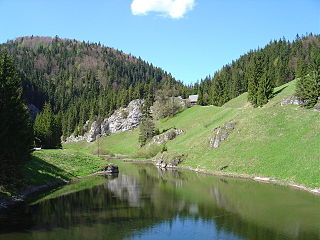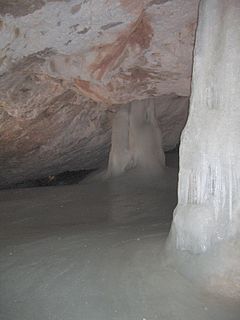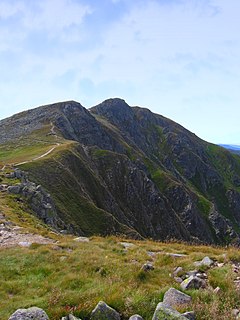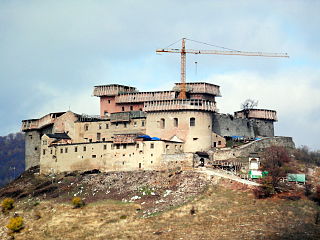See also
| Wikimedia Commons has media related to Caves in Slovakia . |
There are more than 2,400 caves in Slovakia , of which more than 400 have been explored so far. New caves are being discovered constantly.
Note: The list is incomplete
| Wikimedia Commons has media related to Caves in Slovakia . |

The Low Tatras or Low Tatra is a mountain range of the Inner Western Carpathians in central Slovakia.
Gömör was an administrative county (comitatus) of the Kingdom of Hungary. In the 19th century, and in the beginning of the 20th century, it was united with the Kis-Hont County to form Gömör-Kishont County. Its territory is located in southern Slovakia and northern Hungary. Today names Gömör/Gemer are only an informal designation of the corresponding territory without administrative role.

The Slovak Karst is one of the mountain ranges of the Slovenské Rudohorie Mountains in the Carpathians in southern Slovakia. It consists of a complex of huge karst plains and plateaus. Since 1973 it was a protected landscape area. On 1 March 2002 Slovak Karst National Park was declared. It is also a UNESCO Biosphere Reserve and part of it forms UNESCO World Heritage site Caves of Aggtelek Karst and Slovak Karst.

Slovak Paradise is a mountain range in eastern Slovakia. It is a part of the Spiš-Gemer Karst, which in turn is a part of the Slovak Ore Mountains, a major subdivision of the Western Carpathians. It is located between the towns of Spišská Nová Ves in the north and Dobšiná in the south. It is particularly known for its gorges and waterfalls. It is very popular with hikers as it has a number of unusual routes through gorges and waterfalls. There are numerous sections where fixed ladders are used to climb. The area is protected by Slovak Paradise National Park.

The Slovak Ore Mountains are an extensive mountainous region of Slovakia's Spiš and Gemer region, and in small part in northern Hungary, within the Carpathians. It is the largest mountain range in Slovakia. In the geomorphological system, the Slovak Ore Mountains belong to the Inner Western Carpathians.

Malá Fatra is a mountain range in the Western Carpathians in the north-west of Central Slovakia. In the geomorphological system, it is a part of the Fatra-Tatra Area.

An ice cave is any type of natural cave that contains significant amounts of perennial (year-round) ice. At least a portion of the cave must have a temperature below 0 °C (32 °F) all year round, and water must have traveled into the cave’s cold zone.

Tourism in Slovakia offers natural landscapes, mountains, caves, medieval castles and towns, folk architecture, spas and ski resorts.

Stará Lesná or "Old Forest" is a village and municipality in Kežmarok District in the Prešov Region in north-central Slovakia. Stará Lesná is located in an area traditionally known as Spiš and it is situated within the Slovak Tourism Region of the Tatras.
Pavčina Lehota: is a village and municipality in Liptovský Mikuláš District in the Žilina Region of northern Slovakia. The village is known mainly for tourism because of its location among the famous attractions of large caves, aqua parks, ski resorts that surrounds the village.

Dobšiná Ice Cave is an ice cave in Slovakia, near the mining town of Dobšiná in the Slovak Paradise. Since 2000 it has been included on the UNESCO World Heritage list as a part of the Caves of Aggtelek Karst and Slovak Karst site.

Demänovská Cave of Liberty is a karst cave in Low Tatras in Slovakia. Discovered in 1921 and opened to the public in 1924, it is the most visited cave in Slovakia.

The Domica cave is situated on the south-western border of the Silicka planina Plateau 10 km (6.2 mi) south-east of Plesivec in the Rožňava District of the Košice Region in southern Slovakia and in combination with the Baradla cave represents the most significant section of the Aggtelek Karst and Slovak Karst cross-border cave network that continues into the in Hungary.

Demänovská Ice Cave or Demänovská ľadová jaskyňa is an ice cave in the Demänovská Valley in Slovakia. It was first mentioned in 1299 and is one of oldest known caves in Europe. After the opening of Demänovská jaskyňa Slobody in 1924, interest in this cave declined. It was reopened to the public after the reconstruction of wooden stairs and electrical lighting in 1952, with 680 m accessible out of the 1,975 m. Currently, the route for visitors is 850 m long and takes about 45 minutes to traverse.

Jasovská Cave is a speleothem limestone cave and archaeological site in the Slovak Karst in Slovakia. It is located near the village of Jasov, around 25 km (16 mi) from Košice city.

Tatra(s) National Park is one of the nine national parks in Slovakia. It is situated in North Central Slovakia in the Tatra Mountains. The park is important for protecting a diverse variety of flora and fauna, with many endemic species, including the Tatra chamois.

Low Tatras National Park is a national park in Central Slovakia, between the Váh River and the Hron River valleys. The park and its buffer zone cover the whole Low Tatras mountain range. The National Park covers an area of 728 km² and its buffer zone covers an area of 1,102 km², which makes it the largest national park in Slovakia.

Liptov is a historical and geographical region in central Slovakia with around 140,000 inhabitants. The area is also known by the German name Liptau, the Polish Liptów, the Hungarian Liptó and the Latin name Liptovium.

The Krásna Hôrka Castle is a castle in Slovakia, built on a hilltop overlooking the village of Krásnohorské Podhradie near Rožňava, in Košice Region. The first recorded mention of the castle was in 1333. In 1961 Krásna Hôrka was designated a National Cultural Monument of the Slovak Republic. It was said to be one of the country's best-preserved castles. On 10 March 2012 the castle was extensively damaged by fire, due to some teens carelessly discarding a cigarette which set the grass on fire.